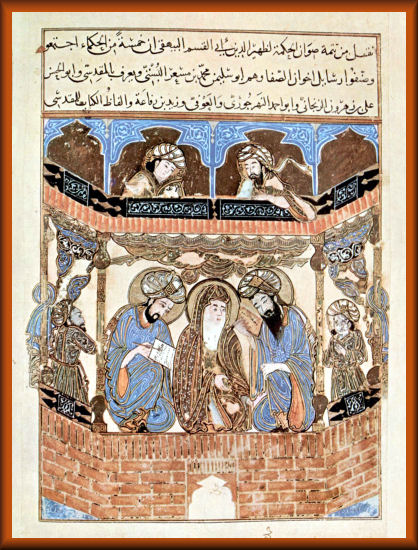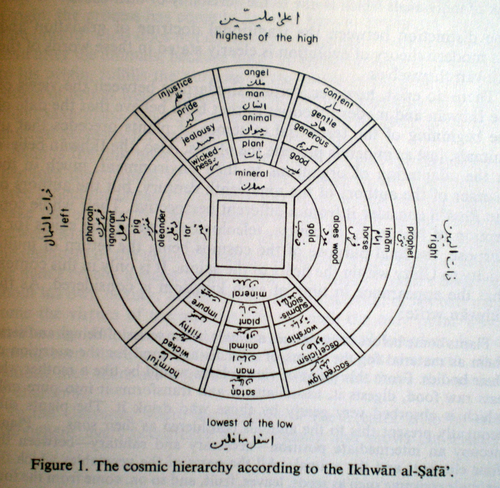Ikhwan as-Safa
Ikhwan as-Safa is a Muslim sect, popularly known as the “Brethren of Purity” who published the encyclopedia Rasa’ il (ca. 989), a forty-eight volume series.

This sect, which was centered in Basra—a thriving seaport at
this time and a marketplace of foreign influences—believed in the
purifying power of knowledge. Ikhwanian writings and teachings
represented a Gnostic effort to reconcile Hellenistic beliefs with the
teachings of the Quran. Pythagorean and Neoplatonic mystical concepts
were dominant in the Brethren’s rationales.
They viewed geometric shapes as personalities bearing special
attributes. The triangle represented harmony. The square represented
stability and promoted the Four Element theory and thus a special status
for the number 4 (reminiscent of the Chinese cosmological reverence for
the number five). Of this fourfold division of Nature, the Ikhwans
wrote:
God himself has made it such that the majority of the things of Nature are grouped in four such as the four physical natures which are hot, cold, dry and moist; the four elements which are fire, air, water and earth; the four humours which are blood, phlegm, yellow bile and black bile; the four seasons . . . , the four cardinal directions . . . , the four winds . . . , the four directions envisaged by their relation to the constellations; the four products which are the metals, plants, animals and men.( Nasr, An Introduction to Cosmological Doctrines, p. 50. For a more detailed discussion of Ikhwanian beliefs see Seyyed Hossein Nasr, Science and Civilization in Islam (Cambridge, MA: Harvard University Press, 1968), 152–57)
For the Ikhwans, as for the Pythagoreans, number appeared to be
the key for understanding the relationships upon which the physical
and spiritual world functioned. They developed their own system of
abjad for the numerical symbolism of letters and devised numerical
categories to clarify relationships.
In particular, the Brethren divided all beings and objects into nine states, since 9, the last digit in the decimal numeration system, closes a cycle and symbolically brings an end to the series of numbers. The categories are as follows:
The process of creation is divided twofold: first, God creates ex nihilo the Intellect; immediately after the Intellect’s emanation (fayd), it proceeds gradually, giving shape to the present universe. The order and character of emanation are described below. (rasa’il Ikhwan al-Safa’, vol. 1 p. 54; cf. rasa’il Ikhwan al-Safa’, vol. 3 pp. 184, 196-7; 235)
(1) Al-Bari’ (Creator, or God) is the First and only Eternal Being, no anthropomorphic attribute is to be ascribed to Him. Only the will to originate pertains to Him. The Ikhwan present an Unknowable God (Deus Absconditus) at the top of the hierarchy while the Qur’anic God (Deus Revelatus), another facet of God, guides people on the right path.
(2) Al-’Aql (Intellect or Gr. Noûs) is the first being to originate from God. It is one in number as God Himself is One. God created all the forms of subsequent beings in the Intellect, from which emanated the Universal soul and the first matter. It is clear, in the opinion of the Ikhwan, that the Intellect, a counterpart of God, is the best representative of God.
(3) Al-Nafs al-Kulliyya (The Universal Soul) is the Soul of the whole universe, a simple essence which emanates from the Intellect. It receives its energy from the Intellect. It manifests itself in the sun through which is animated the whole sublunary (material) world. What we call creation, in our physical world, pertains to the Universal Soul.
(4) Al-Hayula al-Ula (Prime Matter, arabicized from Gr. hyle), is a spiritual substance that is unable to emanate by itself. It is caused by the Intellect to proceed from the Universal Soul which helps it to emanate and accept different forms.
(5) Al-Tabi’at (Nature) is the energy diffused throughout all organic and inorganic bodies. It is the cause of motion, life, and change. The influence of intellect ceases at this stage of Nature. All subsequent emanations tend to be more and more material and defective.
(6) Al-Jism al-Mutlaq (The Absolute Body) comes about when First matter acquires physical properties, and it is the physical substance of which our world is made.
(7) The World of the Spheres (of the fixed stars, Saturn, Jupiter, Mars, the Sun, Venus, Mercury, and the Moon) appears in the seventh stage of emanation. All the heavenly bodies are made up of a fifth element (ether), and are not subject to generation and corruption.
(8) The Four Elements (fire, air, water, and earth) come immediately under the sphere of the moon where they are subjected to generation and corruption. The Ikhwan adopted the view of Thales (d. c. B.C.E. 545) and the Ionians that the four “elements” change into one another, water becomes air and fire; fire becomes air, water, earth, etc.
(9) The Three Kingdoms are the last stage of emanation. The three kingdoms (mineral, plant, and animal) are made of proportional intermixture of the four elements.

The first four numbers in this series and the entities in the first four categories were, by the Pythagorean concept of tetractys, considered to be pure, universal beings since, within their sum, they contained all numbers. The other beings are compound objects.
No comments:
Post a Comment